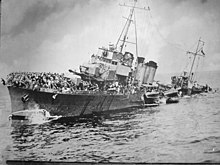Bourrasque (ship)
|
||||||||||||||||||
|
||||||||||||||||||
|
||||||||||||||||||
|
||||||||||||||||||
The Bourrasque was a Bourrasque- class destroyer of the French Navy . On May 30, 1940, the ship was lost in the evacuation of Allied troops during Operation Dynamo .
Type ship
In most cases, the first ship of a class becomes the name-giving ship. This was not the case with the Bourrasque class. The Bourrasque was the seventh ship of the class to be keeled and only the tenth when it was launched. Since the final equipment went very quickly before commissioning, the Bourrasque became the type ship. However, the sister ship Simoun was put into service almost four months off the Bourrasque .
Construction history and technical data
The keel laying of Bourrasque was in the Navy Yard et Ateliers on 12 November 1923 Chantiers de France in Dunkirk . The launch took place on August 5, 1925 and the commissioning on August 23, 1926.
The ship was 106 m long, 9.64 m wide and had a maximum draft of 4.3 m. The standard displacement was 1,298 ts and the maximum displacement was 1,968 ts. Three steam boilers supplied two steam turbines, each of which drove a propeller via a shaft. The power was 31,000 PS (22,800 kW) with which the ship could reach a speed of 33 kn (61 km / h). The ship's bunkers could hold 360 tons of heavy fuel oil . These were sufficient for 3,000 nautical miles at 15 kn.
The armament of the Bourrasque consisted of four 13.0 cm cannons model 1919. These were set up in individual suspensions. The air defense consisted of a 7.5 cm anti-aircraft gun model 1924; this was located amidships behind the chimneys. As a torpedo armament, the ship had six torpedo tubes in two groups of three. In addition, she had two drop racks for 16 depth charges at the stern.
Fall and Fate
The Bourrasque took part under the command of Capitaine De Fregate Robert Gabriel Arthur Fouque as part of Operation Dynamo in the relief of Allied troops from Dunkirk. On May 30, 1940, the ship ran into a sea mine and was then sunk by German gunfire. The Bourrasque is located at 51 ° 14 '58 " N , 2 ° 33" 2 " E at a depth of 25 m. At that time, the ship had around 1,200 soldiers from Dunkirk on board. The losses in the sinking amounted to about 500 men.
literature
- Roger Chesneau: Conway's All the World's Fighting Ships 1922-1946 . Conway Maritime Press, Greenwich, ISBN 0-85177-146-7 .
- John Jordan, Jean Moulin: French Destroyers: Torpilleurs d'Escadre & Contre-Torpilleurs 1922–1956 . Seaforth Publishing, Barnsley, ISBN 978-1-84832-198-4 .
- MJ Whitley: Destroyers of World War Two . Naval Institute Press, Annapolis 1988, ISBN 0-87021-326-1 .
- MJ Whitley: Destroyers of World War Two: An International Encyclopedia . Cassell & Co, London 2000, ISBN 1-85409-521-8 .

